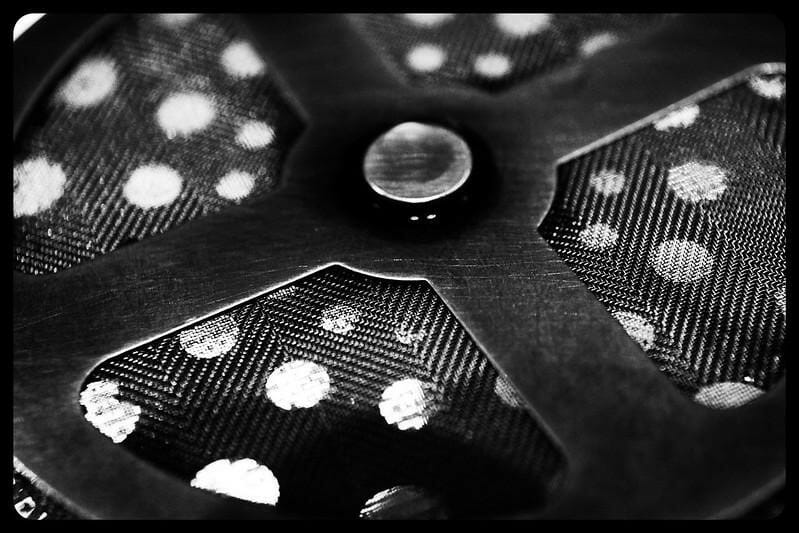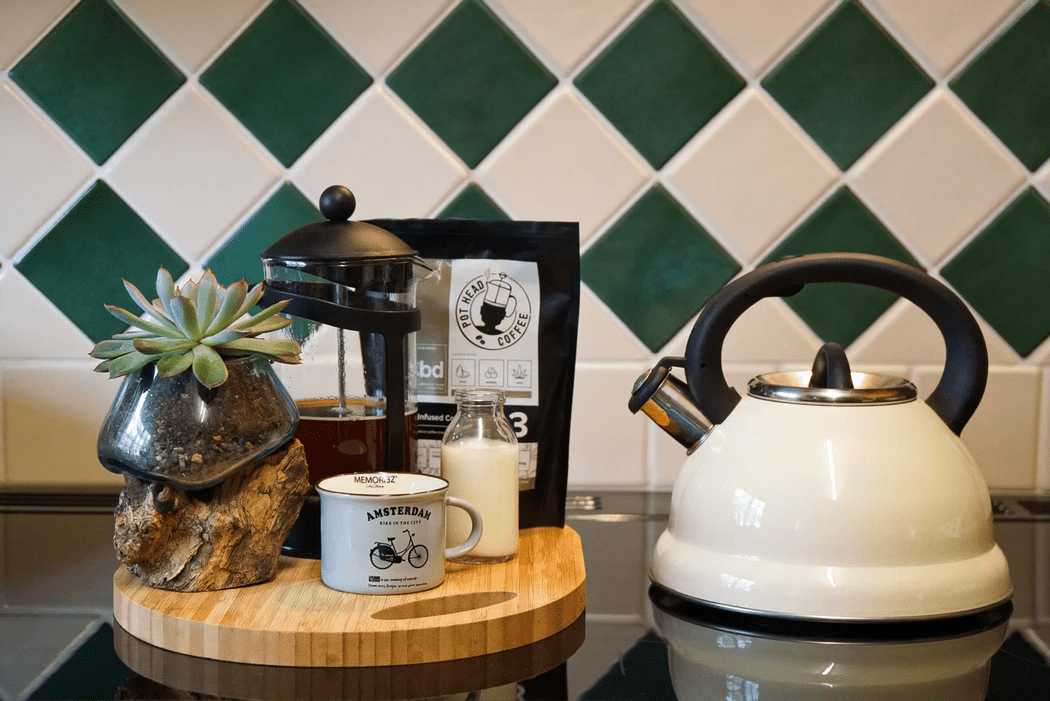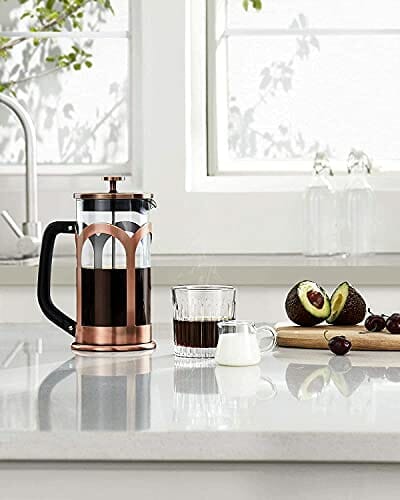Despite the rise of automatic coffee makers with state-of-the-art functions and design, nowadays many coffee lovers still pick the French Press to brew their favorite cup of coffee.
In this article, I will show you how to use a French Press and some tips to make the best cup of coffee.
I’ll also address some of the common concerns coffee drinkers have about the French Press.
What Is French Press Coffee
French Press coffee refers to coffee made using the French Press. It’s a hand-operated coffee maker that can also be known as a cafetiére, a coffee plunger, or a press pot.

How Does A French Press Work
The coffee maker has two main parts:
A cylindrical beaker (carafe) with a handle and a base
The coffee grounds and hot water are added to the beaker.
And the act of letting the coffee steep while immersed in the water is called immersion brewing.
The handle and the base are there to keep your hands and counter surface safe from the heat.
A plunger (piston) and a filter attached to the lid
The French Press today has undergone many modifications over time but still retains the signature pressing or plunging operation to make a cup of coffee.
That is why its many names revolve around that action.

On the modern machine, the plunger, as a metal rod, runs through the center of the lid fitting the beaker.
At the bottom of the rod, a fine mesh filter usually made of stainless steel is attached to allow only desirable coffee particles and oils to pass through.
And at the top of the rod is a small knob.
After letting the coffee grounds steep for a couple of minutes, you hold onto the knob and press the plunger to make the infamous French Press coffee.
Traditionally, a French Press coffee maker makes it work with only a single layer of mesh metal filter.
Newer models may come with double or even triple filter screens.
And, although paper filters are not needed when using this appliance, some coffee lovers still do.
Well, to each their own.
What You Need To Make French Press Coffee
1. A French Press (Obviously)
2. A Mug
3. Ground Coffee
Preferably, you should use the freshest ground coffee, which means buying whole coffee beans and grinding them yourself.
If you are thinking of getting a coffee grinder for fresher and better-tasting coffee, maybe you’ll find your new best friend among our best picks here!
The key to brewing the best French Press is using medium to dark-roast coffee beans for a slower extraction of favorable flavors and oils.
And make sure to get the medium-coarse grind size to attain optimal grounds to water surface area exposure and balanced extraction.

Using finer ground coffee tends to lead to over-extraction and more unwanted coffee particles slipping into your brew.
4. Water
Try to use spring water or filtered water so that you don’t have to worry about foreign particles getting into your coffee brew.
5. Access to heat and a kettle
Be it a digital or stovetop kettle or a pot over an open fire, as long as you can make boiling water with it, you’re good to go.
6. A stirring spoon
A spoon, a chopstick, or anything you can find at your convenience to do the job.
7. A measuring cup or more
More dishes to wash but better get that ratio right before adding it to the beaker.
8. A scale
You can use a scale to accurately measure the amount of ground coffee and water to meet the chosen ratio.
However, if one is not available, measuring spoons and cups can suffice.
9. A timer
Use a timer to correctly time steeping for balanced coffee extraction.
You can drop this once it’s become a natural rhythm in your busy mornings, but for beginners, stick to the plan.
If for some reason you don’t have any clock or timer with you, another interesting way to roughly time your brew is using songs!
10. A container
One that can bear the heat as you serve the drink over the hour.
11. A water thermometer (optional)
Grab a water thermometer with you if necessary as coffee aficionados know that we use near-boil water to brew. Otherwise, you can let the water boil and let it rest for a bit before using it to make coffee.
What’s The Right French Press Ratio (Coffee To Water Ratio)
Too bad there’s no Golden Ratio or Rule of Thumb that’s perfect for everyone. Each person has a different preference.
Luckily, it’s easy to use, learn, and adjust to match your palate and figure out your own best French Press ratio. Providing the grounds quality and the water temperature stay constant throughout your attempts, test the coffee to water ratio by adding or removing will get you closer to attaining that perfect cup of Joe.

- A good starting coffee to water ratio is 1:15.
- If you want your French Press coffee more diluted, do 1:17.
- If you want your French Press coffee stronger, do 1:12 or 1:13.
How To Make French Press Coffee Step-by-Step
Just 10 simple steps, you too can make good coffee.
Step 1: Preparing Water
Depending on the ratio you pick, measure the amount of ground coffee and water using a scale and a measuring cup.
I don’t want to bore you with maths but bear with me for a bit. For example, if you’re brewing with the 1:15 coffee to water ratio, get around:
20 grams of grounds for 300 grams of water (10.2 oz).
If you don’t have a scale, 1 tablespoon is around 5 grams of coffee grounds and 1 cup is around 240 grams of water. To brew in the 1:15 ratio, that translates to around:
4 tablespoons of coffee and 1.27 cups of water.
Step 2: Heating Up Water
Use whatever tool you have to heat the water. As aforementioned, use a thermometer to correctly gauge the water temperature.
The ideal temperature for brewing coffee is between 195 to 205 degrees Fahrenheit (91 to 96 degrees Celsius), according to the National Coffee Association of U.S.A.
If you don’t have a cooking thermometer, watch your water and take the pot off the heat once many small bubbles are rapidly forming and breaking across the water surface.
That’s roughly the temperature we’re aiming for.
Brew around 20 oz of water to use for both Step 4 and Step 5.
Step 3: Preparing Ground Coffee
In the meantime, prepare the coffee grounds to be used following the instructions in Step 1.
This may take time if you’re grinding the coffee beans yourself. Use the medium-coarse grind setting for optimal extraction.
Step 4: Preheating The French Press
Like you would with most other coffee makers, preheating is necessary to maintain the temperature as the coffee brews and keep your coffee hot for a lot longer.
Whether you get a glass or stainless steel French Press, try not to skip this step.
Since everything is completely manual, some tend to find preheating such a hassle.
But don’t fall for the tempting laziness because the difference in your coffee will be worth it.
- Pour hot water into the beaker.
- Swirl the water around and wait until the carafe gets up to heat.
- Discard the water.
Step 5: Adding Ground Coffee And Hot Water
- Add the coffee grounds you prepared to the preheated French Press.
- Pour enough hot water to soak the added grounds.
- Use a spoon to quickly stir the mixture.
Step 6: Letting It Steep
- Cover the French Press with the lid to limit the loss of heat and prevent anything from falling into your coffee.
- Set a timer for 30 seconds and let it steep.
Step 7: More Hot Water And More Steeping
- Pour the rest of the hot water to match your intended coffee to water ratio into the French Press.
- Use the spoon to gently stir the mixture.
- Put the lid and the plunger back on the French Press again.
- Set a timer for 3 minutes and 30 seconds and let it steep. That’s 4 minutes in total.
Step 8: Press Down The Plunger
Here’s what we all have been waiting for: Hold the knob and slowly press the plunger down all the way to the bottom.
As you go, this is when you can tell whether the coffee grind level was appropriate or not to improve later on.
If it feels too smooth sailing, your coffee grind is likely too coarse.
However, if pressing down poses a challenge, that’s a sign of the coffee grind being too fine.
Step 9: Decanting The Coffee
The soaked coffee grounds are now pushed down to the bottom and out of the way.
The content won’t be affected in any way, you might think. But let me remind you: the filter isn’t a separator.
Your coffee is still in contact with the grounds.
And the longer you leave it there, the more extraction will continue to happen, resulting in more and more bitter coffee.
To avoid this, unless you intend to serve it all at once, pour the content into a different container.
Step 10: It’s Coffee Time
Coffee is now ready to be served. Take out your best coffee mug and enjoy your morning with a delicious charge of caffeine.

Find our recommended French Press coffee makers here.
FAQs
How Many Cups Of Coffee Does A French Press Make
A French Press comes in a variety of sizes, either listed in oz/ml or cups.
In the latter’s case, most commonly, you may spot a 3-cup, 4-cup, 8-cup, and 12-cup.
So, does that mean you can get 3 cups of coffee and so on each time you use the French Press coffee maker?
Well… no.
A lot of people are under that impression and get confused when the French Press coffee yield is a lot less than they expected, myself included. Let me help you clear that up.
One cup that the French Press coffee maker manufacturers refer to is only around half of the U.S. cup matric. And a common serving cup or mug in the U.S. is around 1-1.25 cup (8-10 oz/236.6-295.7 ml).
- 3-cup: 12 oz = 354 ml = 1 serving
- 4-cup: 15 oz = 444 ml = 1.5 servings
- 8-cup: 34 oz = 1005 ml = over 3 servings
- 12-cup: 51 oz = 1508 ml = 4-5 servings
Can You Use Regular Ground Coffee In A French Press
Yes. Though you can be picky and use a coffee grinder to make freshly ground coffee beans for the best coffee, the machine is not.
You can use regular pre-ground coffee beans to make a French Press.
However, as aforementioned, make sure to get the medium-coarse and medium to dark-roasted coffee beans.
Then, during step 8 when you press down the plunger, you will know whether you need to get finer or coarser pre-ground coffee beans for a better brew next time. Practice makes perfect!

Why Is My French Press Coffee Bitter – How Can I Make My French Press Less Bitter
Whether you feel like your coffee is too bland or too bitter, try looking into the following factors and start adjusting:
- Roast level: The darker the roast, the more bitter the taste.
- Grind size: The finer the grind, the more bitter the taste.
- Steep time: The longer you steep, the more bitter the taste.
- Brewing ratio: Go for a 1:12 or 1:13 coffee to water ratio if you want a stronger brew. Likewise, adjust to a 1:17 if you find our suggestion still too strong for your taste.

Does French Press Coffee Have More Caffeine
According to this study about the effects of different extraction methods, French Press coffee has a much lower caffeine concentration than others.
For example, for the Espresso brewing method, around 4.10 mg/ml of caffeine content is found, whereas only 0.52 mg/ml is present in French Press.
However, many variables can shift these figures, such as the serving cup size.
But even in their signature serving sizes, a cup of French Press is still a lot less caffeine-packed than a cup of Espresso.
So if you need an energy shot, you know where to go.
Is French Press Coffee Bad For You
Back in 2016, just as French Press started to become the favorite of many and considered to be hip among coffee aficionados, a blog article posted on Harvard Medical School states that French Press coffee can be bad for you with high consumption.
To make French Press coffee, most don’t use a paper filter in addition to the mesh filter that comes with the coffee maker.
The lack of a filter leads to more coffee oils called diterpenes slipping into your cup of coffee that aren’t the best for your body.
“Five to eight cups a day of unfiltered coffee may actually raise your ‘bad’ LDL cholesterol”.
And to no one’s surprise, the article ended up catching a lot of attention and many started to question their French Press coffee consumption habit.
So how true is it? According to this study in 2012, coffee does extract cafestol, a diterpene, and the level of extraction and concentration vary by roast time and coffee preparation method.

And the result is, the French Press is among the brewing methods that have the most impact on cafestol concentration and extraction yield.
And according to this other article from Harvard Health Publishing, paper filters can trap potentially harmful oils, something that metal filters like those on the French Press struggle with.
Enough science talk. The bottom line is: Yes, drinking a lot of French Press coffee can raise the risk of increasing your cholesterol levels.
However, unless you drink as often as more than four cups of French Press a day and have related health problems, plunger all the way.
If you are still worried, you can incorporate a paper filter into your French Press brewing routine.
And that was how to use a French Press, along with some clarifications on some of your common concerns.
Now you can confidently pull out your new coffee maker and brew a cup.



